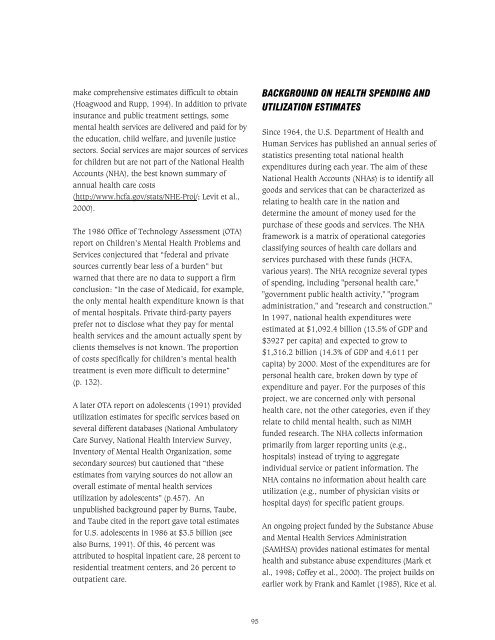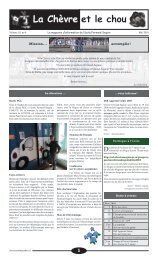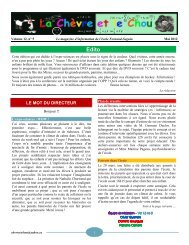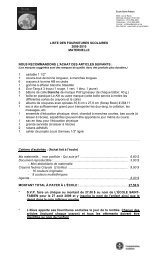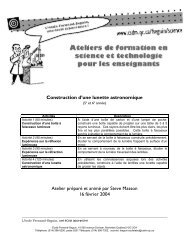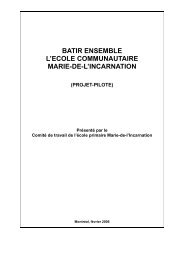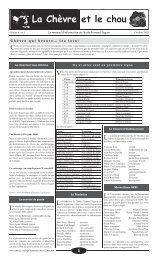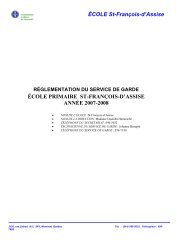Research on Child and Adolescent Mental Health
Research on Child and Adolescent Mental Health
Research on Child and Adolescent Mental Health
You also want an ePaper? Increase the reach of your titles
YUMPU automatically turns print PDFs into web optimized ePapers that Google loves.
make comprehensive estimates difficult to obtain<br />
(Hoagwood <strong>and</strong> Rupp, 1994). In additi<strong>on</strong> to private<br />
insurance <strong>and</strong> public treatment settings, some<br />
mental health services are delivered <strong>and</strong> paid for by<br />
the educati<strong>on</strong>, child welfare, <strong>and</strong> juvenile justice<br />
sectors. Social services are major sources of services<br />
for children but are not part of the Nati<strong>on</strong>al <strong>Health</strong><br />
Accounts (NHA), the best known summary of<br />
annual health care costs<br />
(http://www.hcfa.gov/stats/NHE-Proj/; Levit et al.,<br />
2000).<br />
The 1986 Office of Technology Assessment (OTA)<br />
report <strong>on</strong> <strong>Child</strong>ren’s <strong>Mental</strong> <strong>Health</strong> Problems <strong>and</strong><br />
Services c<strong>on</strong>jectured that “federal <strong>and</strong> private<br />
sources currently bear less of a burden” but<br />
warned that there are no data to support a firm<br />
c<strong>on</strong>clusi<strong>on</strong>: “In the case of Medicaid, for example,<br />
the <strong>on</strong>ly mental health expenditure known is that<br />
of mental hospitals. Private third-party payers<br />
prefer not to disclose what they pay for mental<br />
health services <strong>and</strong> the amount actually spent by<br />
clients themselves is not known. The proporti<strong>on</strong><br />
of costs specifically for children’s mental health<br />
treatment is even more difficult to determine”<br />
(p. 132).<br />
A later OTA report <strong>on</strong> adolescents (1991) provided<br />
utilizati<strong>on</strong> estimates for specific services based <strong>on</strong><br />
several different databases (Nati<strong>on</strong>al Ambulatory<br />
Care Survey, Nati<strong>on</strong>al <strong>Health</strong> Interview Survey,<br />
Inventory of <strong>Mental</strong> <strong>Health</strong> Organizati<strong>on</strong>, some<br />
sec<strong>on</strong>dary sources) but cauti<strong>on</strong>ed that “these<br />
estimates from varying sources do not allow an<br />
overall estimate of mental health services<br />
utilizati<strong>on</strong> by adolescents” (p.457). An<br />
unpublished background paper by Burns, Taube,<br />
<strong>and</strong> Taube cited in the report gave total estimates<br />
for U.S. adolescents in 1986 at $3.5 billi<strong>on</strong> (see<br />
also Burns, 1991). Of this, 46 percent was<br />
attributed to hospital inpatient care, 28 percent to<br />
residential treatment centers, <strong>and</strong> 26 percent to<br />
outpatient care.<br />
BACKGROUND ON HEALTH SPENDING AND<br />
UTILIZATION ESTIMATES<br />
Since 1964, the U.S. Department of <strong>Health</strong> <strong>and</strong><br />
Human Services has published an annual series of<br />
statistics presenting total nati<strong>on</strong>al health<br />
expenditures during each year. The aim of these<br />
Nati<strong>on</strong>al <strong>Health</strong> Accounts (NHAs) is to identify all<br />
goods <strong>and</strong> services that can be characterized as<br />
relating to health care in the nati<strong>on</strong> <strong>and</strong><br />
determine the amount of m<strong>on</strong>ey used for the<br />
purchase of these goods <strong>and</strong> services. The NHA<br />
framework is a matrix of operati<strong>on</strong>al categories<br />
classifying sources of health care dollars <strong>and</strong><br />
services purchased with these funds (HCFA,<br />
various years). The NHA recognize several types<br />
of spending, including "pers<strong>on</strong>al health care,"<br />
"government public health activity," "program<br />
administrati<strong>on</strong>," <strong>and</strong> "research <strong>and</strong> c<strong>on</strong>structi<strong>on</strong>."<br />
In 1997, nati<strong>on</strong>al health expenditures were<br />
estimated at $1,092.4 billi<strong>on</strong> (13.5% of GDP <strong>and</strong><br />
$3927 per capita) <strong>and</strong> expected to grow to<br />
$1,316.2 billi<strong>on</strong> (14.3% of GDP <strong>and</strong> 4,611 per<br />
capita) by 2000. Most of the expenditures are for<br />
pers<strong>on</strong>al health care, broken down by type of<br />
expenditure <strong>and</strong> payer. For the purposes of this<br />
project, we are c<strong>on</strong>cerned <strong>on</strong>ly with pers<strong>on</strong>al<br />
health care, not the other categories, even if they<br />
relate to child mental health, such as NIMH<br />
funded research. The NHA collects informati<strong>on</strong><br />
primarily from larger reporting units (e.g.,<br />
hospitals) instead of trying to aggregate<br />
individual service or patient informati<strong>on</strong>. The<br />
NHA c<strong>on</strong>tains no informati<strong>on</strong> about health care<br />
utilizati<strong>on</strong> (e.g., number of physician visits or<br />
hospital days) for specific patient groups.<br />
An <strong>on</strong>going project funded by the Substance Abuse<br />
<strong>and</strong> <strong>Mental</strong> <strong>Health</strong> Services Administrati<strong>on</strong><br />
(SAMHSA) provides nati<strong>on</strong>al estimates for mental<br />
health <strong>and</strong> substance abuse expenditures (Mark et<br />
al., 1998; Coffey et al., 2000). The project builds <strong>on</strong><br />
earlier work by Frank <strong>and</strong> Kamlet (1985), Rice et al.<br />
95


